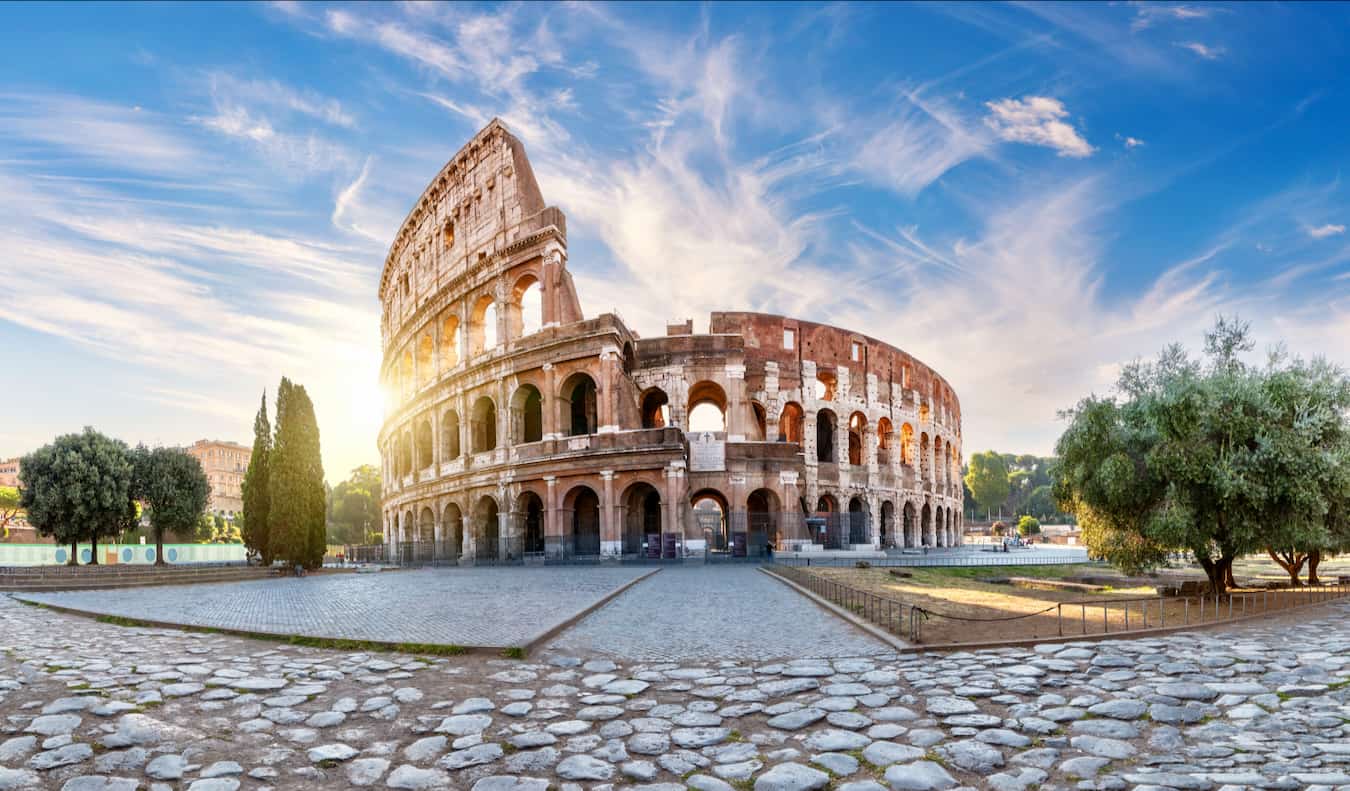
Posted: 11/17/22 | November 17th, 2022
Rome is a city of layers stretching back centuries. You’re never far from ruins or stunning ancient or classical architecture. One moment you’re passing a modern building, the next you’re staring at some Doric columns from the Roman Republic, a Renaissance-era palace designed by Michelangelo, or a piazza centered around a Bernini-designed Baroque fountain.
There are some cities — New York, London — that offer so many attractions, you can’t help but to create a list to check off. And then there are others where you just want to wander and absorb the vibe and the aesthetics of it all.
Rome is both.
In some ways, it feels like a village, with its venerable, wise ambiance, and in others like a cosmopolitan city, since there are so many museums, historical landmarks, and great restaurants.
Obviously, it’s impossible to see everything in one visit. It’s what happens when you have a city of millions dating back three thousand years.
Which begs the question: What should you do when you may never come back? How do you decide what to do?
To help you make the most of your limited time in this iconic capital, here is the list of my top things to do in Rome:
1. Walking Tour
I love taking walking tours. They’re a wonderful way to learn about a destination. I recommend Rome’s Ultimate Free Walking Tour or New Rome Free Tours. They cover all the highlights and can introduce you to the city on a budget. Just be sure to tip your guide at the end.
If you’re looking for a paid guided tour that goes above and beyond, check out Take Walks, which offers one of the best walking tours in Rome, with expert guides who can get you behind the scenes at the best attractions. They can get you behind the scenes like no other tour company, including early access to the Sistine Chapel and skip-the-line Colosseum tours.
If a food tour is more your speed, Get Your Guide runs a tasty 2.5-hour tour with 5 stops for just 42 EUR while Devour offers an in-depth street food tour and pizza-making class for 89 EUR.
2. The Colosseum
Easily one of the most recognizable and jaw-dropping sights in the world, this first-century amphitheater is one of the top attractions in Rome. There were 80 entrances/exits in this super stadium: 76 for attendees/spectators, 2 for participants (i.e., gladiators), and 2 for the emperor. While that might seem like an excessive number, the Colosseum could hold a whopping 50,000 people in its day, and getting them in and out needed to be done quickly.
Buy your entry tickets at the nearby Palatine Hill entrance at Via San Gregorio 30, where the line is much shorter, or buy them online (your ticket grants access to Palatine Hill and the Roman Forum).
You can also book a tour with Walks of Italy if you want a more in-depth experience.
Piazza del Colosseo, +39 06-699-0110, parcocolosseo.it. Open daily 9am–sunset. Admission is 16 EUR.
3. The Roman Forum
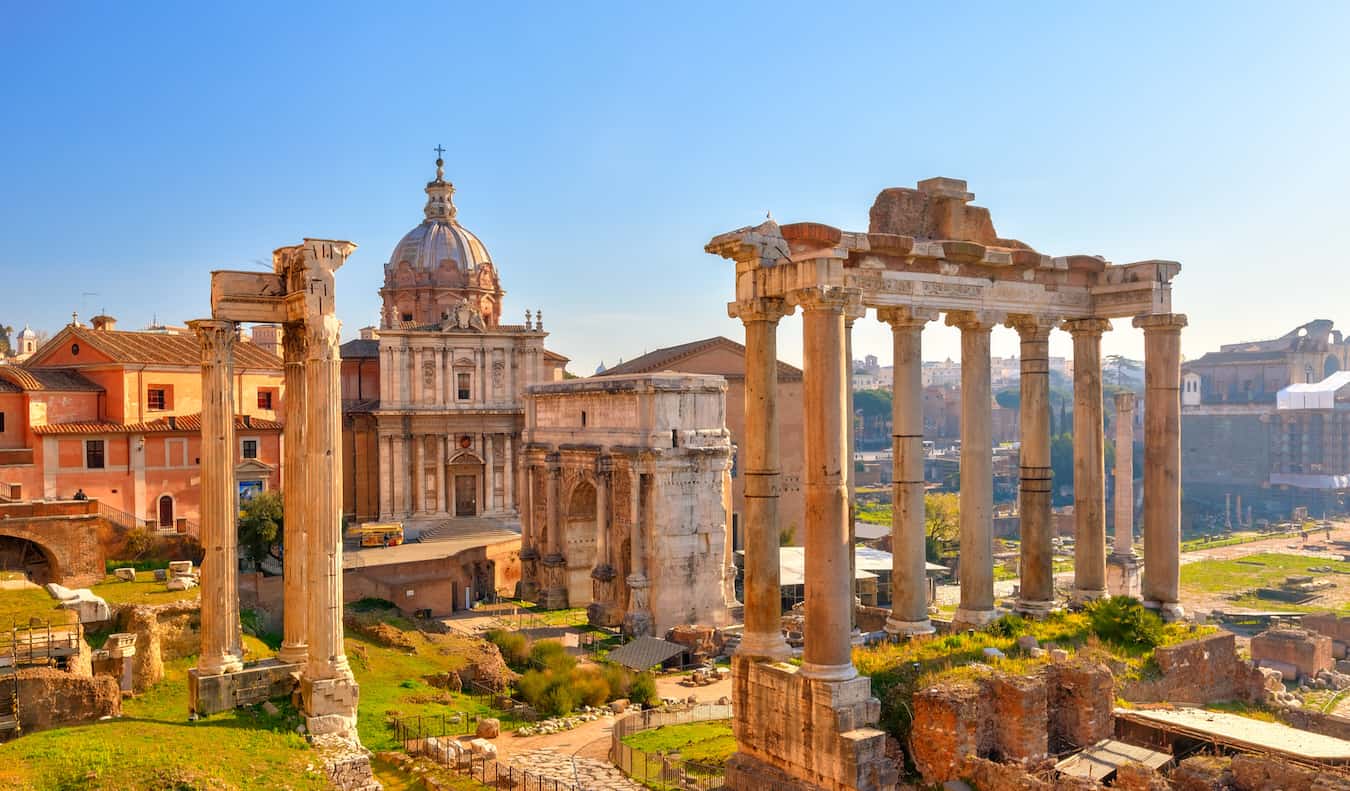
Once the center of the known world, the Roman Forum today might just be stumps of marble and half-standing temples, but it’s one of the most haunting sites in town. You have to use your imagination a bit, but this swath of dirt and marble was once bustling, lined with shops, open-air markets, and temples.
The Via Sacra is the main street that cuts through the Forum, the place where all roads in the empire either began or ended. Once the empire fell, the Forum became a pasture for farm animals; it was known in the Middle Ages as Campo Vaccino, or Cow Field. Over the centuries, much of the marble was plundered, and the area was eventually buried as the center point of Rome shifted. It wasn’t until the 19th century that archeologists began excavating and rediscovering the Forum.
Via della Salara Vecchia, +39 06-3996-7700, parcocolosseo.it. Open daily 9am–sunset. Admission is 16 EUR. The ticket gets visitors into the Colosseum and Palatine Hill.
4. Explore the Vatican Museums
Home to the famous Sistine Chapel, the Vatican Museums house four miles of rooms and hallways bedecked with one of the world’s great art collections. In addition to the Michelangelo masterpiece on the chapel’s ceiling, there are rooms frescoed by Raphael and paintings by Da Vinci, Titian, Caravaggio, and Fra Angelico, among others, plus halls and halls of ancient Greek and Roman statuary, Egyptian mummies, and Etruscan relics.
TIP: Don’t join the mile-long line in the morning like everyone else. Instead, go after lunch, when you can practically walk right in without waiting at all.
Skip the line tickets cost 26 EUR. If you’d prefer a guided tour, skip-the-line tours cost 69 EUR and last 3 hours.
Viale del Vaticano, +39 06 6988-4676, museivaticani.va. Open Monday–Saturday 9am–6pm. Admission is 18 EUR.
5. St. Peter’s Square and St. Peter’s Basilica
The grandest of church in the Catholic world, St. Peter’s was designed by a veritable Renaissance and Baroque dream team: Bernini took care of the two column-filled arms that surround the square, Bramante created an early design for the basilica, and Michelangelo put the dome on top. One hundred and twenty years after construction began, the church was finally consecrated in 1626. It sits on the spot where a fourth-century church once sat and on top of the spot where St. Peter himself was crucified. His bones are still below, where there is an ancient necropolis.
Inside the basilica you’ll find soaring domes featuring angels and cherubs blissfully floating around a partly cloudy sky, as well as plus-sized marble sculptures of saints, popes, and Biblical figures. For 8 EUR, you can climb the 551 steps to the top of Michelangelo’s dome. For 2 EUR more, you can take an elevator.
Piazza San Pietro, +39 06 6982 3731, vatican.va. Open daily 7am–7pm. Admission is free.
6. Campo de’ Fiori
One of the most organic-feeling squares in Rome, this central space — whose name means “field of flowers” — is home to the historic center’s morning fruit and veggie market. The sculpture on a pedestal in the center of the square is that of Giordano Bruno, who was burned here after he got on the pope’s bad side for criticizing the Church. The sculpture was erected in the late 19th century, when the state of Italy and the Catholic Church were at odds with each other. It’s no coincidence that the somber face of the sculpture is looking in the direction of the Vatican.
7. Visit Santa Maria del Popolo
This church on one of Rome’s prettiest squares is said to be located on the spot where Emperor Nero was buried. A millennium after his death, there were still tales of ghosts and ghouls who haunted the place, so the pope had a church built there in order to quell the haunting. It worked.
Parts of the church have been redesigned through the centuries, including the apse by Bramante and frescoes in some of the chapels by Pinturicchio. But the real draw is the two jaw-droppingly gorgeous Caravaggio paintings on display in the chapel, just to the left of the altar. Most people come for these, but the Chigi chapel was designed by Raphael and completed by Bernini, so don’t miss that, either.
Piazza del Popolo 12, +39 06 361 0836. Open daily 7am–1pm and 4pm–7pm. Admission is free.
8. See Piazza Navona
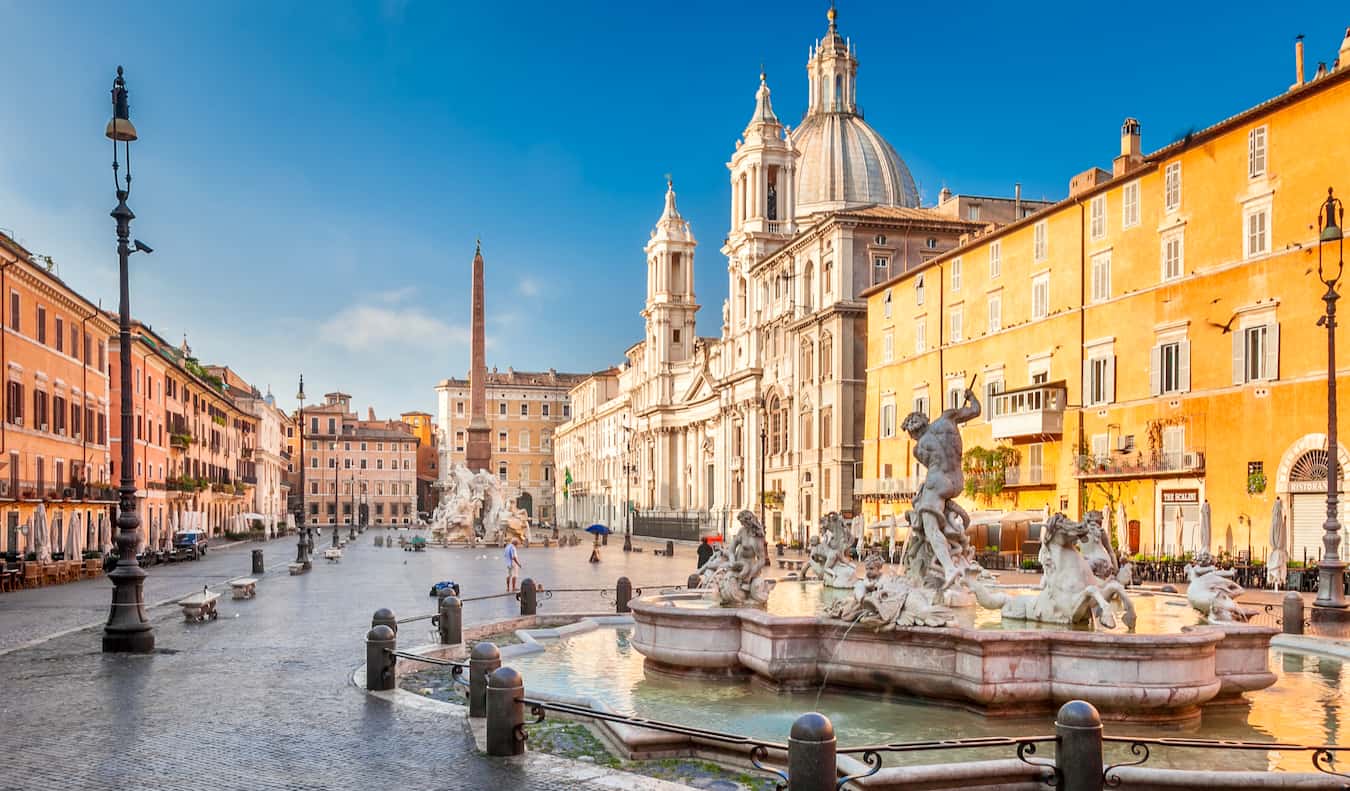
Rome’s most popular piazza began as an ancient Roman circus (as its oval shape will testify), where horse racing and other sporting events took place. Today, the main sport is sitting at an outdoor café and nursing a beverage while gawking at tourists and locals alike. Don’t miss Bernini’s best fountain in the center of the square, Fontana dei Quattro Fiumi (Fountain of the Four Rivers). It’s pure drama set in stone.
9. Explore Testaccio
Located south of the vast city center, Testaccio is an erstwhile working-class neighborhood. Younger Romans might associate it with nightlife and clubbing, as there have long been a number of clubs hugging up against Monte Testaccio, the historic mound that the neighborhood is centered around.
Older Romans will associate the neighborhood with food because, in the 19th century, it was home to the city’s main slaughterhouse. As part of their pay, workers at the slaughterhouse would receive a bag of raw meat to take home, also known as the “fifth quarter” — the tail, intestines, and stomach, among other parts. Sometimes instead of going home, workers would take their “fifth quarter” to a local restaurant and have it cooked for them there. As a result, this became the de facto local cuisine, and the district was where some of Rome’s most famous dishes were born.
10. Villa Borghese and Borghese Gardens
At 60 hectares (148 acres), the Villa Borghese property — a swath of verdant grass dotted with umbrella pines northeast of the historic center — makes up Rome’s second largest parkland. In ancient times, the area was known as the Garden of Lucullus, before becoming a vast vineyard. But in 1605, Cardinal Scipione Borghese — nephew of Pope Paul V and patron to sculptor Gian Lorenzo Bernini — converted the land into a park. The 19th century saw a redesign, with the green space getting a more manicured, English accent.
The property is sprinkled with temples and monuments, all of which had been given a serious sprucing up for the 1911 World Exposition, and its balustrade offers one of the best views of Rome. The park is centered, however, around the Galleria Borghese, which houses one of the city’s greatest art collections (including works by Bernini, Raphael, Titian, and Caravaggio).
Skip the line tickets (that include a guide) are just 50 EUR.
Piazzale del Museo Borghese 5, +39 06 841-3979, galleriaborghese.beniculturali.it. Open daily 9am–7pm. Reservations are necessary for the Galleria (admission is 13 EUR), but the park is always free.
11. Admire Santa Maria della Concezione (I Cappuccini)
Sandwiched between the posh thoroughfare Via Veneto and car-snarled Piazza Barberini, this church is a relatively ordinary 17th-century structure. There is a dramatic altarpiece in a chapel of St. Michael the Archangel by Baroque painter Guido Reni, but that’s not necessarily why you should make it a priority to get here.
The reason is in the crypt, accessible from the street-level side of the church. Commonly just called I Capuccini, it is one of the most macabre sights in all of Europe: the bones of 4,000 friars, many of them still in full skeletal form (and many still wearing their brown habits), grace the walls of the long, narrow room with five chapels. Other bones were used to create ornamental objects: shinbone chandeliers hang from the ceiling, and pelvic bones are arranged to make an ersatz hourglass. In the last chapel, a plaque offers a sober — if somewhat appropriate — reminder: “What you are now, we once were; what we are now, you shall be.”
Via Veneto 27, cappucciniviaveneto.it. Open daily 10am–7pm. Admission is 8.50 EUR.
12. The Spanish Steps
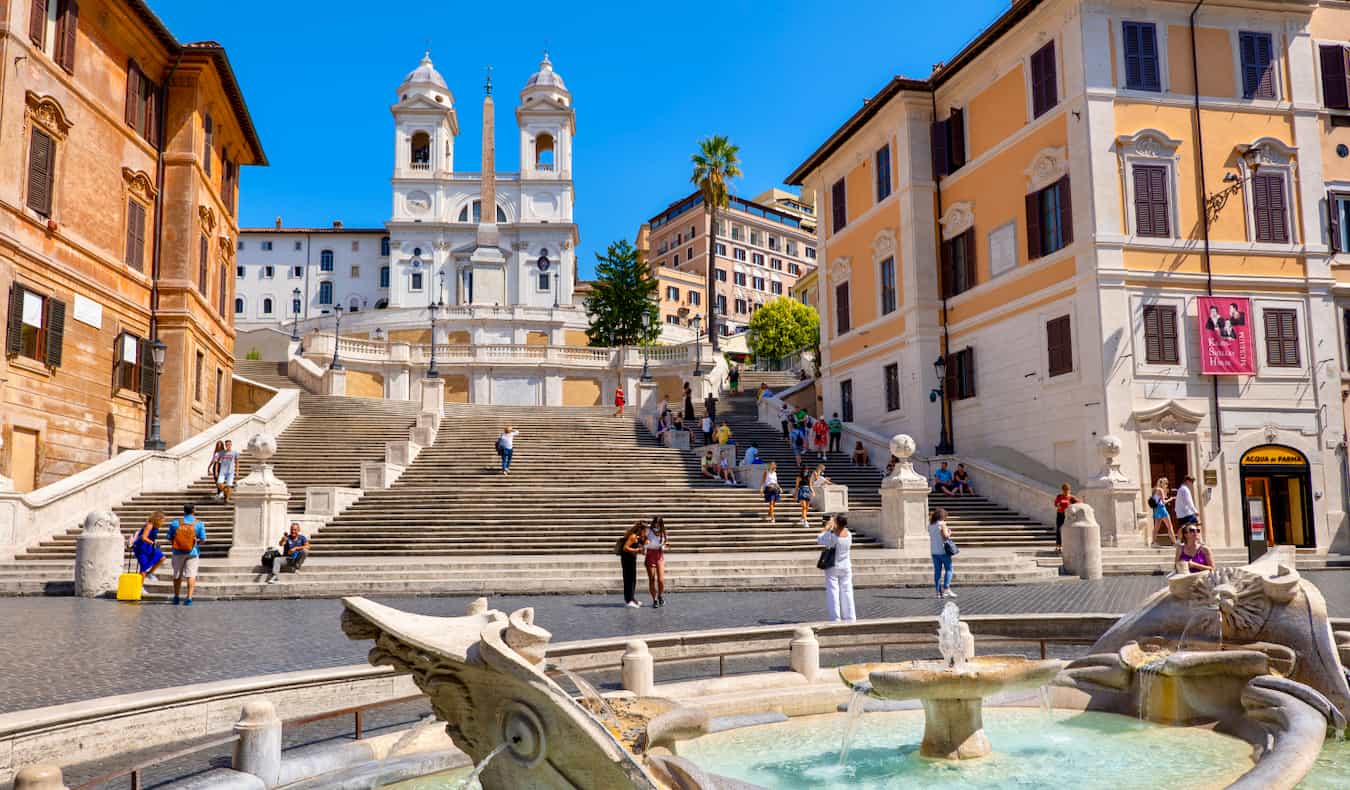
The world’s most famous set of steps were completed in 1725 for the purpose of easing church-goers’ ascension up the then muddy hill to the church of Trinità dei Monti. The bottom of the stairs features a modest fountain by Bernini. The name comes from the fact that the Spanish embassy has long been on the square where the stairs spill out.
A recent law makes it forbidden to sit on the steps, so the time-honored tradition of eating gelato while lounging on the steps is now just a memory. But it’s worth strolling up the stairs nonetheless.
13. Trevi Fountain
More a theater of waterworks than a fountain, the iconic Trevi Fountain is best viewed in the early morning or late at night, when the area is devoid of the miasma of picture-taking tourists. Every year, at least one crazy tourist — usually under the influence of Italian wine or other substances — decides it would be a good idea to go for a swim.
Fun fact: the coins that people toss in the fountain (totaling thousands of euros each day) are given to the Red Cross.
14. Ara Pacis
The Ara Pacis — or Altar of Augustan Peace — is an ornate marble altar made in the decade before Christ’s birth. It was commissioned to celebrate the Pax Augusta, the empire-wide peace that existed under the rule of Emperor Augustus. Specifically, it was made to celebrate the emperor’s own conquest north of the Alps in the year 13 BCE. The four walls of the altar show scenes of Roman mythology. Be sure to have a look at the interesting depiction of a pig slaughtering on the west wall — a common practice when Romans made a peace treaty.
The altar was an obsession of Mussolini, who was determined to be thought of as the next Augustus. The Ara Pacis, facing the tomb of Augustus where Mussolini hoped to be interned one day, is surrounded on three sides by Fascist-era buildings. Il Duce wanted to turn the area around the altar into a “Fascist theme park.” Fortunately, he didn’t succeed.
The stark white structure that now houses the Ara Pacis was designed in 2006 by American architect Richard Meier. It was the first civic building constructed in Rome’s historic center since World War II and is a favorite target for conservative politicians, who regularly threaten to destroy it.
Lungotevere in Augusta, +39 06-060-608, arapacis.it. Open daily 9:30am–7:30pm. Admission is 13 EUR.
15. San Pietro in Vincoli
Tucked away in the central, but untrammeled, Monti district that’s wedged between the Roman Forum and Termini railway station, this ancient place of worship doesn’t look like much from its simple arcaded façade. But those who venture inside are rewarded. The interior of this fifth-century church, its nave flanked by Doric columns, is home to one of Christianity’s most esteemed relics: the chains that once held Saint Peter (hence the church’s name: Saint Peter in Chains), hanging in view underneath the altar.
And while it’s a place of pilgrimage for the devout, art aficionados are lured here for another reason: Michelangelo’s magnificent sculpture of Moses. The sculpture of the bearded Biblical figure was actually meant to be part of the monumental 47-statue tomb of Pope Julius II that he had hoped would be his final resting place. But plans were scrapped — the project’s pomp and audacity came under serious fire — and all that we’re left with today are Moses and a few unfinished (but graceful and quasi-erotic-looking) slave sculptures.
Piazza S. Pietro in Vincoli 4a, +39 06 488-2865, lateranensi.org/sanpietroinvincoli. Open daily 8am–12:30pm and 3pm–6pm. Admission is free.
16. The Baths of Caracalla
Named after Roman Emperor Caracalla, who had the baths constructed in 217 CE, this massive bath complex was more than just a place to relax by the pool. In ancient Roman society, baths were an institution. In fact, they dotted the city in the same way gyms are sprinkled through modern cities.
The Baths of Caracalla, however, were the grandest of them all. It could accommodate up to 1,500 bathers at a time, who would usually undergo the entire process: a Turkish bath followed by a few minutes in the calidarium (similar to a sauna), then the tepidarium (a pool of lukewarm water), which was followed by a dip in the freezing frigidarium and, at last, the natatio, a huge, open-air swimming pool where Roman men would congregate to gossip and talk politics. The baths lasted some 300 years before invading Goths destroyed the plumbing, causing a fatal hemorrhage of water.
Viale delle Terme di Caracalla 52, +39 06 3996 7700, soprintendenzaspecialeroma.it. Open Tuesday–Sunday 9am–7pm. Admission is 10 EUR.
17. The Pantheon
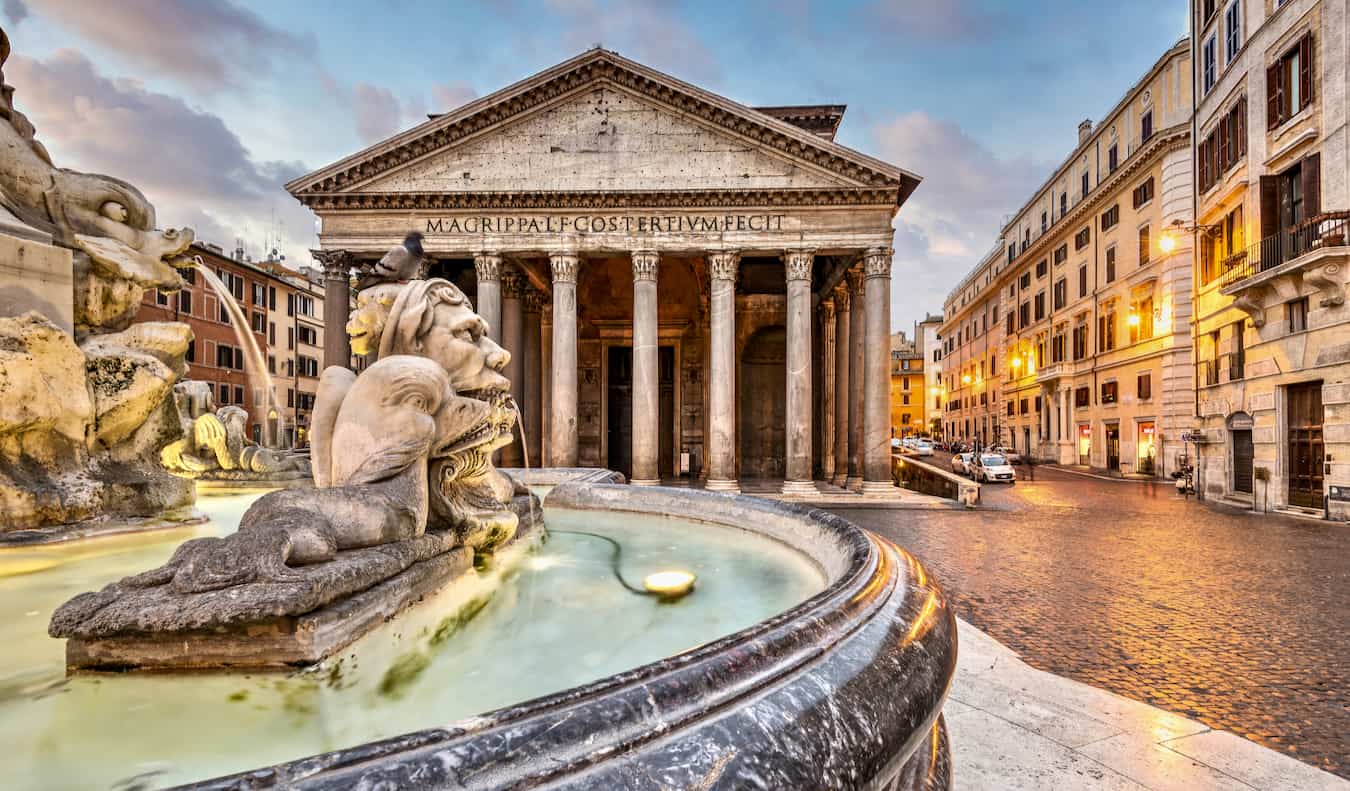
Built around 125 CE, this “temple to all gods” is one of the most majestic buildings still standing from antiquity and an absolute must-see any time of day (though morning is the least crowded). The then-revolutionary rotunda design became the blueprint for buildings for centuries after. Today the Pantheon is the final resting place for some of Italy’s most famous citizens, including the artist Raphael, King Vittorio Emanuele II, King Umberto I, and Queen Margherita of Savoy.
The building used to have a dynamic copper roof. That is, until artist Bernini five-fingered the copper for his 95-foot tall canopy in the just-built St. Peter’s Basilica. You can purchase an audio guide for 8.50 EUR.
Piazza della Rotunda, +39 347 82 05 204, pantheonroma.com. Open daily 9am–7pm. Admission is free.
18. Santa Maria sopra Minvera
During the Middle Ages, Rome was in serious decline: at one point, the population had fallen to just 20,000. Even the popes didn’t want to be there (many escaped to Viterbo, 80 miles north of the Eternal City, and even Avignon in the south of France). There wasn’t much construction going on for a few centuries, which is why Santa Maria sopra Minerva, located a cobblestone’s throw from the Pantheon, is the only Gothic church in town.
The church actually takes its names from the temple of the pagan god Minerva that it’s built over. Inside, admire the starry-skied ceiling, but don’t miss the Michelangelo sculpture of Christ holding up the cross. There’s also a “Madonna and Child” painted by Renaissance master Fra Angelico.
In the piazza in front of the church is one of the most unique sculptures in the history of art: an Egyptian obelisk plopped on top of a sculpture of an elephant. Bernini found the obelisk in the garden of the church’s monastery, and the monks suggested putting it in the middle of the square in front of the church. Bernini, being an artistic genius with a fine sense of humor, carved an elephant — a symbol of piety and intelligence — and affixed the obelisk to the top. It was originally meant as a joke, but it’s remained there ever since.
Piazza della Minerva 42, +39 06-679-3926, santamariasopraminerva.it. Open daily 11am–3pm and 5pm–7pm. Admission is free.
19. The Appian Way (Appia Antica)
The Roman road system was one of the marvels of the ancient world. And the Appian Way — or, as the locals call it, the Appia Antica — was once a superhighway, stretching from the capital all the way to the “heel” of the boot (to the town of Brindisi). The section of “the Queen of Roads,” as it’s nicknamed, that lies just outside of Rome is now a 6,000-acre public park and one of the best off-of-the-radar sites of the Eternal City.
The road begins at the third-century CE Aurelian Walls and the Gate of San Sebastian and then is quickly met with ancient Christian catacombs. Soon the brick-sized cobblestones give way to large, irregularly shaped, pizza-sized basalt stones, complete with ruts made from centuries of Roman chariots moving up and down the road. Crumbling, millennia-old mausoleums and shady umbrella pines flank the road, which is completely traffic free on Sundays. Remnants of mosaic-floored villas and stadiums line the road and make for a perfect excuse for a breather.
20. San Giovanni in Laterano
This gigantic barn of a church is one of the most important in the Catholic world. The ornate Baroque and Rococo façade belies its age, although it’s the oldest among the four major basilicas of Rome (St. Peter’s, Santa Maria Maggiore, and St. Paul’s Outside the Walls being the other three). The entire complex, which also consists of a palace just across the square (today split by a busy street), was the original home base of the pope; until 1870 all popes were crowned here. Today, the church is still the official ecclesiastical seat of the Bishop of Rome (who happens to be the pope).
The basilica was completely renovated in the 18th century and given a full flourish of ornate Baroque design. Alessandro Galilei won the competition to reconstruct the exterior (giving the façade a more palace-like look), and Francesco Borromini was given the job to redesign the interior. He left the central Gothic Baldacchino (canopy) over the altar, which today appears wildly out of place.
Piazza San Giovanni in Laterano 4. Open daily 7am–6:30pm. Admission is free.
21. Trastevere
Literally meaning “across the Tiber,” Trastevere is Rome’s most enchanting, achingly charming neighborhood (and my favorite area to stay in when I’m visiting the city). The narrow winding streets are lined with atmospheric cafés and bars so grab a table on a cobbled lane, order a glass of wine or a beer, and enjoy the people-watching.
22. Santa Croce in Gerusalemme
The floor of this legendary basilica, located on the periphery of Rome’s historic center, may look like a normal, tiled floor now, but when the church was first consecrated in 325 CE, it was covered in soil. But this was no ordinary dirt. It was brought from Jerusalem. Which is fitting, since this magnificent, off-the-tourist-radar basilica was built to hold the supposed True Cross.
It was founded by the aforementioned St. Helena, the mother of the first Christian emperor (Constantine) and one of the Catholic Church’s first relics fanatics. She traveled to the Holy Land in search of the cross Jesus was crucified on. And when she returned home, she had a lot more than just a chunk of the True Cross. Today, the objects from her travels in the Holy Land are on display in a Fascist-era chapel in a back room of the church: thorns from Christ’s cross, a pole he was flagellated on, and a finger from St. Thomas (the same one he allegedly stuck in Christ’s side).
Though the church is 1,700 years old, it got the Baroque treatment in the mid-18th century, which is responsible for the structure’s present appearance.
Piazza Santa Croce in Gerusalemme 12, +39 06 701 4769, santacroceroma.it/en. Open Monday–Saturday 7am–12.45pm and 3.30–7:30pm. Admission is free.
23. Castel Sant’Angelo
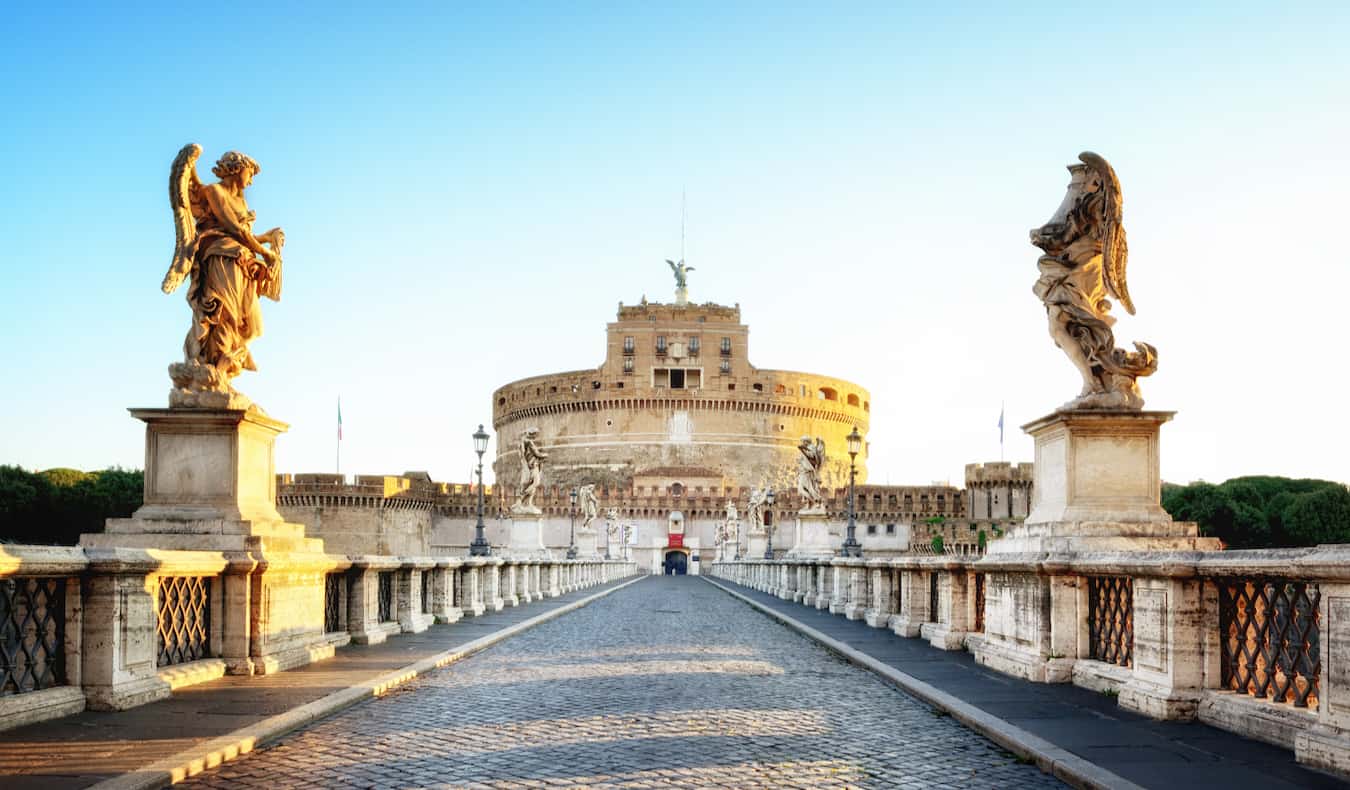
This giant stone structure on the banks of the Tiber began life as a monolithic mausoleum for Emperor Hadrian in the second century CE. In the Middle Ages, it served as a fortress for the pope, who would lock himself inside when the city was under attack. Now that the pope doesn’t have to worry as much about sieges by barbarians, Castel Sant’Angelo is a great place to wander. The gently sloping circular ramps shuttle visitors to the roof, which affords a fantastic view of Rome and the Vatican.
Lungotevere Castello 50, +39 06 681 9111. Open daily 9am–7:30pm. Skip-the-line tickets are 22 EUR.
24. Santa Maria della Vittoria
This unassuming Baroque church, a short distance from the historic center, is a must-see sight for art lovers. In the fourth chapel on the left is Bernini’s massive sculpture, The Ecstasy of St. Teresa, which shows the Spanish mystic laying on a cloud and, in a near orgasmic trance, being pierced by the hot arrow of an angel.
If you think the subject is a little ambiguous, you’d be right. The work of art is the closest one could come to the sculptural theater without making the subjects move. Try to see the angel from as many angles as possible: from one, it looks like the angel has a tender smile; from another, that same smile looks like one of anger.
When St. Teresa had her heavenly encounter, she wrote: “So intense was the pain, I uttered several moans; so great was the sweetness caused by the pain that I never wanted to lose it.”
Via Venti Settembre 17, +39 06 4274 0571. Open daily 9am–noon and 3:30pm–6pm. Admission is free.
Rome is a massive city brimming with historic sites and amazing food. And I’ve only scratched the surface of things to do in the Italian capital. With a never-ending stream of churches that double as de facto art galleries, a lively nightlife, and iconic wonders of the world like the Colleseum, it’s no wonder that this is one of the most popular destinations in the world.
Book Your Trip: Logistical Tips and Tricks
Book Your Flight
Find a cheap flight by using Skyscanner. It’s my favorite search engine because it searches websites and airlines around the globe so you always know no stone is being left unturned.
Book Your Accommodation
You can book your hostel with Hostelworld. If you want to stay somewhere other than a hostel, use Booking.com as it consistently returns the cheapest rates for guesthouses and hotels.
Don’t Forget Travel Insurance
Travel insurance will protect you against illness, injury, theft, and cancellations. It’s comprehensive protection in case anything goes wrong. I never go on a trip without it as I’ve had to use it many times in the past. My favorite companies that offer the best service and value are:
Ready to Book Your Trip?
Check out my resource page for the best companies to use when you travel. I list all the ones I use when I travel. They are the best in class and you can’t go wrong using them on your trip.










